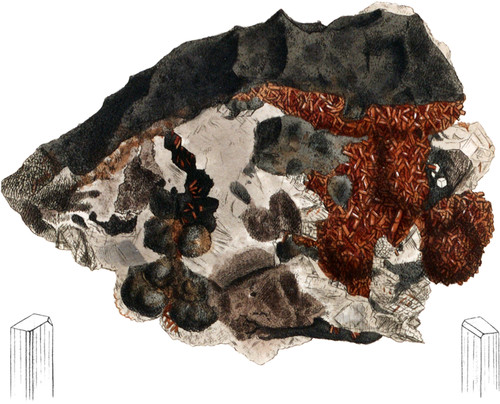 Enlarge
Enlarge
Exotic Mineralogy
Red Sulphuret of Arsenic. Realgar
- Syn.
- Arsenic sulphuré rouge. Haüy, Traité 4. 228. Tabl. 109.
- Rothes-rauschgelb. Emmerl. 2. 563. Werner, &c.
- Realgar. Kirw. 2. 261.
- Red Orpiment. Jameson 2. 477.
The two Sulphurets of Arsenic have long been considered as varieties of one species, for Chemists have been at variance about their composition; some considerting them to differ in the quantity of Sulphur; others suppose that Oxygen is the agent that distinguishes them; while some think that the difference lies in the state of aggregation, and that this is produced by fusion; that the yellow Sulphuret becomes red when melted is certain, it also loses its lamellar structure, but its powder, unless it have been heated long, is still yellow; the same takes place with pure Sulphur. The powder of Realgar, whether native or artificial, is always orange, and in direct combinations of Sulphur and metallic Arsenic, made by heat, the powder is of a deeper and redder orange, in proportion as the quantity of Arsenic is increased, from which I am inclined to adopt the old opinion that the red Sulphuret contains less Sulphur than the yellow, wherefore I shall call the yellow, Super-Sulphuret, and the red only Sulpluret, of Arsenic.
Realgar, or Sulphuret of Arsenic, is generally massive, but when crystallized it is in rhomboidal prisms, with from one to eight terminating faces. De Lisle, and Haüy after him, consider four of the terminal planes as primitive, and corresponding with the faces of an octaëdron, exactly similar to that of Sulphur; but the Count de Bournon calls the lateral planes primitive: I will not pretend to decide between such high authorities. The vertical edges of the prism are often bevilled or truncated.
In a heat below redness it is almost entirely volatilized with a blue flame and white smoke; a character, which, joined to its rod colour and orange powder, will distinguish it from all other minerals in whatever form it may occur. Its crystals appear to be produced by the action of the vapour of Sulphur upon the surface of Native Arsenic, upon which they very commonly rest. In the neighbourhood of Volcanoes much is produced in amorphous masses sublimed along with the Sulphur, and taking some of the same external forms as if it had run among stones. It often colours the Muriate of Ammonia and other products of sublimation in the same situations.
The specimen I have delineated is from Nagyag. I have borrowed it from Mr. Heuland’s extensive private collection. The principal mass is Native Arsenic penetrating a reddish Hornstone, accompanied by minute crystals of Quartz, and a considerable quantity of lenticular Carbonate of Lime.
Bergman’s analysis of Native Realgar gave 90 of Arsenic and 10 of Sulphur. Kirwan’s, 84 Arsenic and 16 Sulphur. Westrumb’s, 80 Arsenic and 20 Sulphur. Thenard found in the Realgar of Commerce, 75 Arsenic and 25 Sulphur.

